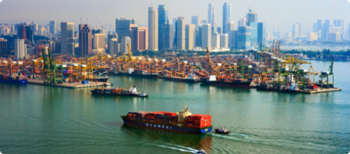
Despite the difficult shipping markets in 2016 traffic in the world’s busiest shipping lane – the Straits of Malacca and Singapore (SOMS) – were up 3.4% to a new all time high of 83,740 transits.
The figures for 2016 were the fifth year of steady growth for traffic in the Straits since 2012, when 75,477 vessels over 300gt transited the straits, according to analysis of the Malaysian Marine Department’s STRAITREP figures by the Nippon Maritime Center (NMC).
The average number of daily transits reported to Port Klang VTS in Malaysia in 2016 was 229, up seven from 2015, and compares to 201 in 2011.
Leading the growth in number of transits in percentage terms in 2016 were VLCCs with 5,973 transits of Straits, an increase of 649 or 12.19% over 5,324 transits by tankers of more than 150,000 dwt in the previous year. This is well above the 4.8% average annual growth in VLCC transits seen since 2007.
As a whole VLCCs account 6% of all transits of the Straits. Loaded VLCCs headed to Singapore and Northeast Asia transit the deepwater lane, which is just 1.3 km wide at One Fathom Bank “goalposts” in the Malacca Strait, and only 800 m wide at one point in the Philip Channel in the Singapore Strait, if sailing eastwards beyond Singapore.
Overall tanker traffic, including VLCCs, in the SOMS was up 5.39% in 2016 to 19,466 transits, an increase of 996 compared to 18,470 transits in 2015, making it the fastest growing segment as a whole.
“The 2016 reports mostly tankers carrying clean oil products, and the yearly increase indicate the growing number of oil refineries in operation within East Asia, especially in China,” the report by NMC commented.
Tankers were the second largest vessel type to use the Straits accounting for 23% of traffic in 2016.
Containerships remained the largest segment to transit the Straits in 2016 with a 33% share of traffic a figure which has remained consistent since year 2000. However, containership transit growth has been relatively slow in recent years with 1.54%, or 393 transits, increase last year to 25,786 compared to 25,393 in 2015.
The trend towards very large and ultra large containership tonnage has dampened the overall growth in transits. “Container carrying capacity of newer ships have greatly increased in recent times. As a result, container ports in the Straits handled higher cargo tonnage on fewer ships calling in recent years,” the report commented.
The number of containership transits in 2016 still remains marginally below the record of 26,359 set in 2008.
Bulk carrier traffic in the Straits has enjoyed relatively strong and steady growth since 2011 averaging 4.3%, however, it tailed off somewhat last year in what was widely regarded as the worst market in living memory with the Baltic Dry Index hitting an all time low of 290 points in February 2016.
Bulker traffic in the SOMS grew 2.49, or 378 transits, to 15,547 in 2016 compared to 15,169 transits in the previous year. Bulk carriers accounted for 12% of the traffic in the Straits in 2016.
Copyright Ships & Ports Ltd. Permission to use quotations from this article is granted subject to appropriate credit given to www.shipsandports.com.ng as the source.